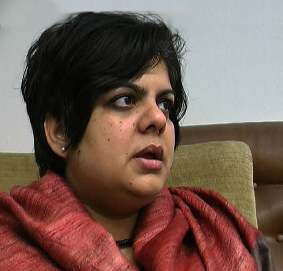 | Born in 1968 in (India) Lives and works in (India ) | Biographie Bibliographie Liste expositions |
 | Born in 1968 in (India) Lives and works in (India ) | Biographie Bibliographie Liste expositions |
Sonia Khurana was born in 1968 in India and is one of a number of Indian artists who received their artistic training abroad, but returned to their home country to work. After having spent two years at the Rijksakademie in Amsterdam, her works have been presented in Europe, namely during the exhibition elles@Centre Pompidou (2009/2010), in Asia at the Busan Biennale (2004) and in the United States during the Global Feminisms exhibition in Brooklyn (2007). She currently works in New Delhi in various media, including video, photography, text, installations and public performances. The themes that she most frequently deals with are those of interiority and identity, using her own body in performance. She thus places experience at the heart of her work, and composes her works based on very personal, even autobiographical, references. For instance, The World (2004) is an installation that presents the artist's grandmother in audiovisual form, as she relates the family's exile after the partition of India in 1974. This video juxtaposes the status of war refugee to that of the modern nomad, a product of globalisation. It was with Bird, produced in 1999 as part of her diploma at the Royal College of Arts in London that she made a name for herself among the upcoming generation of Indian artists. In this short video in black and white, the artist poses naked on a pedestal – a metaphor for a perch that she is attempting to fly from. She goes up on tiptoes, tries to find her balance, attempts to flap her wings, launches herself and then invariably falls to the ground. By attempting to fly, the artist wishes to show that it is difficult to escape from one’s condition. In the literal sense, since the body is confronted with its own flesh and the laws of gravity, but also in the figurative sense, as it is difficult for a woman to escape the rules that society imposes on her. Sonia Khurana is situated in the tradition of women artists working on/with their own body in order to more effectively question sexual differences and representations of femininity. She also speaks of her body as a “site of transmission, transformation and translation of phenomenological interactions, exploring the tension between different forces: social and cultural, dream-like and libidinal.” [1] The installation Closet (2002) deals with the theme of hysteria and neuroses, which are considered to be typically feminine pathologies. Mona's song (2003) pays homage to Mona Ahmed, an Indian figure known as hijra: that is, an individual considered by Indian society to be neither a man nor a woman, but as asexual. This once again encourages spectators to question gender norms. These works produce a critique of the condition of women, demonstrating both the violence that is perpetrated against them, as well as the impossibility of breaking away from a feminine identity defined by a patriarchal society. After her studies in England, above all, Sonia Khurana wanted to show her work in India, where her message would take on its full critical depth. She certainly represents an unusual and disconcerting image of the Indian woman.
Diane-Sophie Girin
Translated by Anna Knight
[1] Sonia Khurana, in Made by Indians!, Paris, 2007 in Elles@centrepompidou, Paris, 2009.